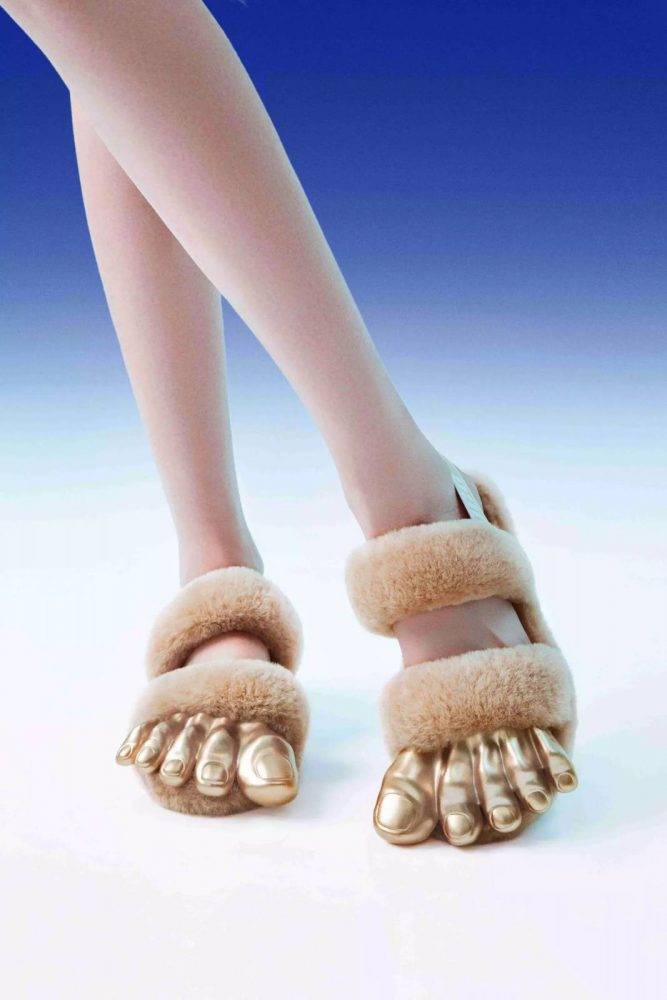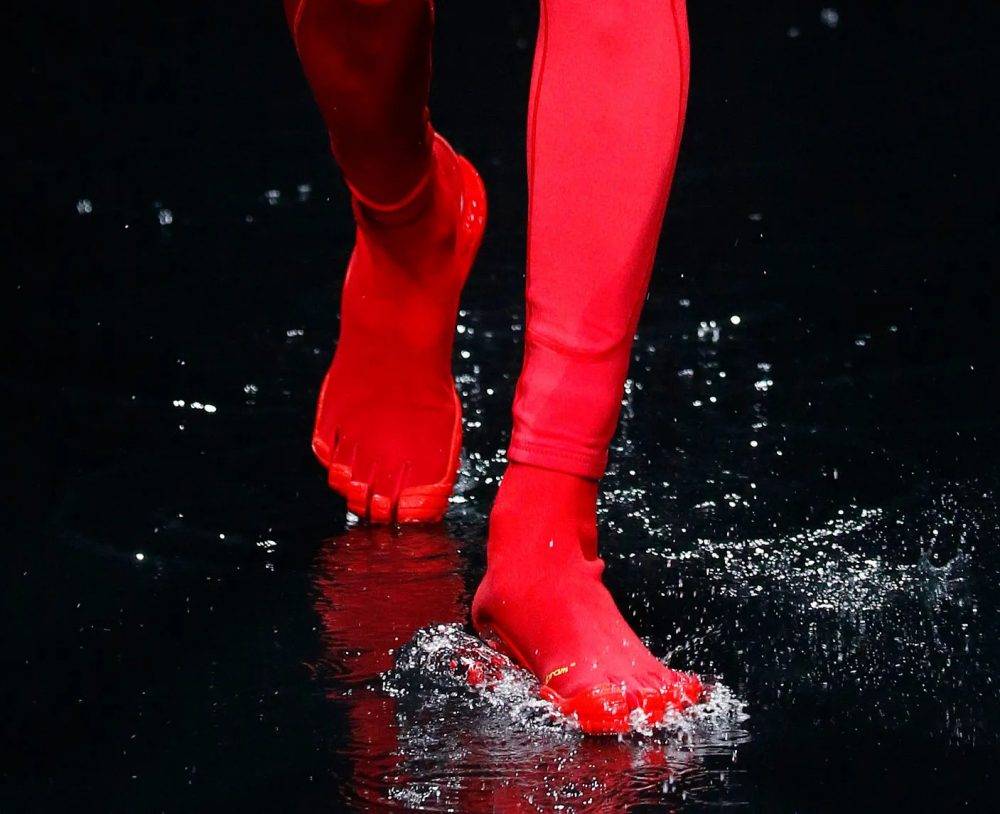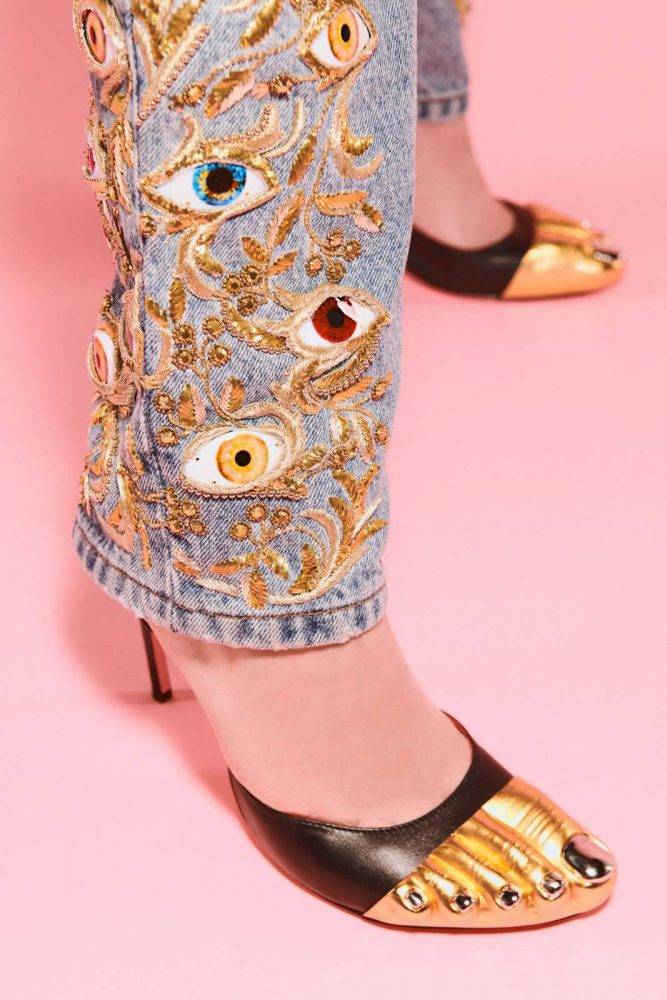Are those comfortable?: Balenciaga toe shoes
The past few seasons have shown that the world’s top designers are going toe to toe with their feet-forward shoes that emphasise toes and tarsals.
Just when we thought shoes could not get weirder, designers are showing us that toe cleavage is the flavour of the month.
At Schiappareli’s January haute couture show, Daniel Roseberry sent his looks down the runway with heels that had the toe contour emphasised, as well as gold-plated claw-like toes. Ugg’s latest collaboration with eyewear designer Victor Wong sees fluffy slippers adorned with massive metallic toes.
Emphasis on the toes and heels is not new for shoe designers. Martin Margiela’s iconic Tabi boots first shook the world in 1988 with their hoof-like shape, which separates the first two toes from the rest, and were inspired by ancient Japanese tabi socks.
 Not toeing the line: Naomi Campbell wore Schiapparelli’s toe pumps to this year’s Vanity Fair Oscars party.
Not toeing the line: Naomi Campbell wore Schiapparelli’s toe pumps to this year’s Vanity Fair Oscars party.
Not only are designers making these shoes but consumers are buying them. Naomi Campbell wore Schiapparelli’s toe pumps to this year’s Vanity Fair Oscars party and Rihanna has showed off the nasty Balenciaga x Vibram toe boots on Instagram.
Margiela’s Tabi boots remain relevant to this day — Google searches for “Maison Margiela Tabi” have grown this year and the brand constantly releases new styles of the two-toed shoe.
There seems to be a range of Margiela Tabi fans, from avant garde weirdos to high-octane hypebeasts. Either way, they are likely to be stopped by strangers who ask, “Are those comfortable?”
Artist, DJ and doula Erykah Badu, known for her funky sartorial choices, has pushed the weird footwear agenda with the tentacle-like shoes she describes as “underwater boogie baby” for her upcoming couture line. The collaboration with a student at London’s Central Saint Martins art school, Myah Hasbany, brings to mind a sea monster — or something more phallic.
These shoes are evidently designed to make the uninitiated uncomfortable. But those who do dare to put their best foot forward have created a kind of club for themselves. Are shoes with toe cleavage one of the fashion world’s longest-running inside jokes?
Sole providers
Beyond “podophilia”, the sexual attraction to feet, fashion’s shoe designers and their obsession with feet has existed throughout history.
The shoes on our feet tell the world a lot more about us than you might think. Shoes are a sartorial choice dictated by style, comfort, function and occasion.
“Shoes are totems of disembodied lust. They are candy for the eyes, poetry for the feet, icing on your soul. They stand for everything you’ve ever wanted,” wrote author Mimi Pond in the 1985 book Shoes Never Lie.
‘Shoes are candy for the eyes, poetry for the feet, icing on your soul. They stand for everything you’ve ever wanted’
An uncomfortable walk back into why humans choose to wear something on their feet shows us today’s need to cover, hide, protect or flaunt our lower extremities.
“The earliest known shoes were crudely tanned animal skins that wrapped around the foot like a modern-day sandal or moccasin,” says Kevin Martel, founder of men’s shoe brand Martel+Ram.
The general belief among shoe designers is that the early steps in people’s pursuit for footwear were soft, flexible and moulded to our feet, says Martel.
 Ugg collaborated with eyewear designer Victor Wong to create these slippers with metallic toes.
Ugg collaborated with eyewear designer Victor Wong to create these slippers with metallic toes.
It was not until about 1850 that shoes were made specifically for left and right feet.
Depending on the occasion, our shoe choices either lean towards form following function or function over form.
The former philosophy points to shoes that are beautiful, unique or outright bizarre, but uncomfortable or impractical, while the latter are those uber-practical shoes that keep you comfortably on your toes for a long period of time.
Uncomfortable footwear with erotic overtones has been documented since the 10th century in China where foot-binding became common practice.
A documentary by the Smithsonian shows how court dancer Yao Niang bound her feet to achieve the shape of the new moon to impress the emperor.
“In addition to altering the shape of the foot, the practice also produced a particular sort of gait that relied on the thigh and buttock muscles for support. From the start, foot-binding was imbued with erotic overtones,” says the Smithsonian.
Foot-binding spread as a symbol of status and wealth — which is not too distant from the undertones of today’s designer shoes. The bound feet of the Chinese elite were similar to the corseted waists of Western aristocrats, where the smaller and more dainty it was, the more attractive and valuable its owner for the economic proposition of marriage.
To achieve the most attractive feet, a young girls’ feet were plunged into hot water and her toenails were cut short. Oil massages followed before all her toes except for the big toe were broken, then bound against the sole to achieve a triangular shape, writes author Dorothy Ko in Every Step a Lotus: Shoes for Bound Feet.
The foot’s arch would be bent to an acute angle before being bound in place using metres of silk strips, which would be replaced every few days to prevent blood and pus from causing infection.
 Erykah Badu has pushed the weird footwear agenda with the tentacle-like shoes she describes as ‘underwater boogie baby’.
Erykah Badu has pushed the weird footwear agenda with the tentacle-like shoes she describes as ‘underwater boogie baby’.
Fast forward to France’s King Louis XIV, who reigned from 1643 to 1715, when shoes shifted from being purely functional to objects of desire. Portraits from that era show Louis wearing shoes featuring “les talons rouge”, or red heels, which spread as a mark of royalty.
Taste for tarsals
Shoes are prominent in stories and are prized objects. Think of Dorothy’s magic red slippers from The Wizard of Oz and Cinderella, whose future as a princess was sealed by a glass slipper that fit her foot like a glove.
Shoes worn by Marie Antoinette, wife of French king Louis XVI, fetched €43 000 when auctioned by Osenat a few years ago and Michael Jordan’s 1985 Nike Air Jordan 1s sold for $560 000 at a recent auction.
 Schiapparelli’s toe pumps
Schiapparelli’s toe pumps
Today, few shoes embody lust like French designer Christian Louboutin’s famous stilettos with red soles, which could perhaps be linked back to the French royals and their talons rouge.
Louboutin has brought fetish through feet to the forefront of fashion. His stilettos have been adorned with everything from spikes and ribbons to swooping sensual arches.
The designer even paired with American director David Lynch for the 2009 Fetish exhibition, which married the taboos of fetish culture with the sex appeal of stilettos.
His stilettos sometimes make mobility almost impossible but “the shortening of the calf muscle introduces a greater contour to the leg”. The black patent leather and incapacitating stiletto heels “invite the inevitable louche sexual associations,” claims the label on an ultra-high pair of Louboutins on display at the The Metropolitan Museum of Art in New York.
Of course, there is a difference between an attraction to feet and a love of shoes, but both have forged communities in their own particular ways.
On TikTok, videos showing Margiela Tabis have amassed more than 10 million views and, on Reddit, the thread for foot fetishes has 250 000 followers, while those displaying pictures of feet have more than 500 000 followers.
Fashion has long sought to make feet — or women’s feet anyway —look slim, dainty and sharp, and supposedly more “feminine”.
Footwear infiltrates pop culture too. Think of the iconic moment in the 2006 movie The Devil Wears Prada when Anne Hathaway as Andrea Sachs walks into the office fashionably drenched in Chanel tweeds and pearls but all eyes are on her feet: “Are those the — the — Chanel boots?” … “Yeah.”
Designers are doing what they seem to do best these days — turning something that is typically ugly into something beautiful, even if the result is more controversial than fashionable.
The golden thread linking many of fashion’s “ugliest” shoes is the feeling of discomfort they intentionally exude. For example, Belgian designer Dries Van Noten’s asymmetrical sandal provides coverage for the first two toes, while leaving the other three exposed.
Consumers may be conditioned to consider a shoe either open-toe or closed-toe but the fact that his sandal is neither, yet both at the same time, makes one question its existence and function.
Phoebe Philo’s 2013 Pedicure Shoe for Celine was designed to make it look as if the wearer wasn’t wearing a shoe but rather had perfectly pedicured red toe nails. Like many of the shoes that are an ode to the toe, Philo’s shoes are hyper-aware of themselves. They are both erotic and uneasy; beautifully made yet nasty; luxurious but lame.
This year, the fashion landscape is chaotic, with new trends popping up every day, such as prep, stealth wealth and extravagant costume dress-up. It’s also been a minute since sneakers have been at the forefront of footwear influence with the rise of loafers, ballet flats, seasonless boots and, of course, the toe-shoe subculture.
It seems that fashion designers love to challenge what we deem stylish by turning footwear into the star of our outfits.
With that said, our excitement is building around how far designers are willing to tiptoe into the realm of even nastier footwear.